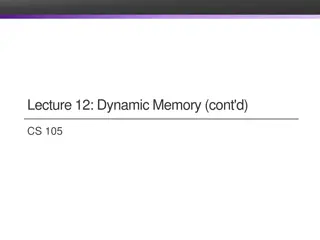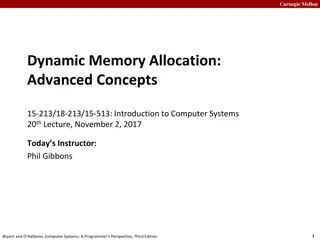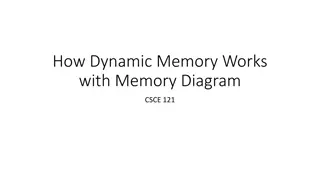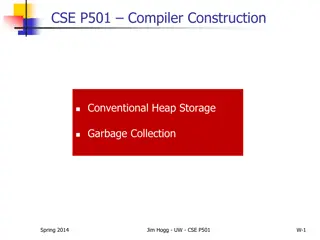Understanding Memory Allocation in the Hippocampus and Cortex
The paper discusses the role of the hippocampus as a stable memory allocator for the cortex, emphasizing the process of memory allocation, chunking, and indexing. It delves into the requirements for stable memory allocation, chunking in a neuroidal model, and addresses problems related to memory formation of new items. The content also explores circuit design and the unique features of neural circuits in information processing.
Download Presentation

Please find below an Image/Link to download the presentation.
The content on the website is provided AS IS for your information and personal use only. It may not be sold, licensed, or shared on other websites without obtaining consent from the author. Download presentation by click this link. If you encounter any issues during the download, it is possible that the publisher has removed the file from their server.
E N D
Presentation Transcript
The Hippocampus as a Stable Memory Allocator for Cortex By Leslie G. Valiant Presented by Jiajia Zhao
Memory Allocation by Hippocampus Cortex: information storage Hippocampus: organizer Chunking: making new items (i.e. concepts) out of a conjunction of existing but separate items Indexing that facilitates information storage This paper: Hippocampus identifies the set of neurons representing a new item, and enables them. First requirement is stability: The # of neurons allocated to a new item (chunk) is controlled within a range Stable Memory Allocator, or SMA
Requirements of SMA Stability Continuity (tolerating faulty neurons) Orthogonality (neuron sets representing different items should be substantially different) With the bio-plausible constrains on Neuron numbers Synapse numbers Synaptic strengths Activity level / density representation Ratio of inhibition to excitation
Chunking in Neuroidal Model An item is represented by a set S of neurons. S is being accessed if more than a fraction y of the neurons are firing S is NOT being accessed if less than a fraction x of the neurons are firing One paper estimated x = 30% and y = 88% The system is configured such that the fraction firing in the intermediate range is extremely rare
Whats the problem JOIN(A,B): memory formation of a new item C that fires iff both A and B are firing May allocate unstable amount of neurons at a memory structure of higher depth Solution: limit the depth needed for memory allocation, since it s the only one with stability problems. Stability: circuits that generate a fixed output spiking pattern of stable size in a few steps
Circuit Design m input neurons and n output neurons, both large (106) and for simplicity, often equal. f(u): unique for a circuit. Input vector u of m 0/1 bits generate output vector of n 0/1 bits Dense(u): density as a measure of activity level in a certain time step. Fraction of 1 s. Ham(u,v): hamming distance. The # of bits on which u and v of the same length differ. a: fraction of bits at which uj= vj= 0 b: fraction of bits at which uj= 0, vj= 1 c: fraction of bits at which uj= 1, vj= 0 d: fraction of bits at which uj= vj= 1 a + b + c + d = 1
SMA Properties Technical Definitions - Stability: For Dense(u) in a wide range [q, s], want Dense(f(u)) to be in a narrow range [p- , p+ ] (e.g. [0.002,0.025] => [0.01-0.001, 0.01+0.001]). Continuity If Ham(u, v) is small, say in range [q, s], want Ham(f(u), f(v)) Ham(u,v). (e.g. 10-3 10 10-4) Orthogonality If Ham(u, v) is large, say in range [q, s], want Ham(f(u), f(v)) Ham(u,v).
Realizing Memory Allocation Supervised Memorization: C fires iff A and B both fire. Set of all neurons is the input and output layer. Firing neuron sets A and B will cause a stable set of neurons D to fire in the output layer. Hence, SMA identifies a stable set of neurons D and gives a way of causing D to fire (when A and B fire). Reduce problem to the simpler SM problem Here, D is the proxy or estimation of C.
Algorithm and Analysis Consider a bipartite graph network with m input nodes and n = m output nodes. Each output node is connected to 4 input node, chosen independently at random and allowing repetitions. Threshold function at each output node, for example x+y+z-2t >= 1.
Updating the Density p: fraction of 1 s in all the inputs. Density. h(p) = Prob(output=1 given p) = (1-p)(1-(1- p)3)+p4 Because of the construction, the output of the (i-1)thlayer is the input of the ithlayer. So now we have an updated value for p.
Convergence to Stability Input layer density: p Output layer density: h(p) = 4p3-6p2+3p Want: density to stabilize to a fixed point p* p*= h(p*) = |h (p*)| < 1 => proves -stability by making |p-p*| increasingly smaller for p in certain range, and after enough iterations it ll converge to 0 With this circuit, p*= . (p*) = 0 < 1. For p in [q, s] where 0 < q < 0.5 < s < 1, we can achieve -stability. Another circuit that conveys stability: x+y-t 1 p* = , (p*) = < 1 => convergence, but at a slower rate
3-Continuity and 1.5-Orthogonality Consider the jthposition in the input vectors u, v, the pair (uj, vj) four possible combinations of values: 00,01,10,11. Circuit: x+y+z-2t 1. An output i has 4 connections, each belongs to one of the 4 regions above. So there s a total of 44=256 possible combinations. For each of the 256 combinations, let U=1 iff circuit fires at output i for u, and let V=1 iff it does for v.
Continuity and Orthogonality cont. X = Prob(U V). D = (b+c) => disagreement, Ham(u,v)/m. E = X/D => expansion, multiplicative increase in disagreement. Can calculate X by case analysis, and also E. We will end up with algebraic expressions such as E = 1+2(a3+d3+D3-D2+3bc(1-D)). With constraints on D, can prove an upper bound for E: E 3. Similar techniques, can prove E 0.719 for all values of D, and some tighter bounds if we make more assumptions on D.
New constraint: Arbitrarily Low Density and Inhibition In real brain p*<< 0.5 Consider a circuit with threshold function x+y+z-2(t1+t2+ +tk) 1. Can be proven that this solves the problem of arbitrarily small p with k (ln3)/p. But this requires the total inhibitory weight to grow linearly with 1/p. Not realistic.
Solution t = 1 iff t1+t2+ +tk 1, which is entirely excitatory. This t however is used as a inhibitory signal in the circuit. Strictly speaking, this is two layers, but we don t consider it that way here. Follow the same style of stability, continuity and orthogonality proof above.
Simulation Results In the range of input densities [0.002, 0.025], using circuit x+y+z-2t 1, where t=1 iff (t1+t2+ +tk 1). k = 109 used to appximate the equilibrium density p = 0.01. With 3 layers, simulation shows all 3 qualities 0.01-stability: For p=0.01. So output density is within range [0.0099, 0.0101] 18-Continuity: For any two inputs with D = b+c, the output differs by at most 18D in expectation. 0.93-Orthogonality: For any two inputs differing in a fraction y of the bits with c = 0 (one bio-plausible assumption that makes tight bounds), the outputs differ by at least 0.93y in expectation.
Conclusion 1. 0.01-stability within 3 layers 2. Valid for any number of neurons above 10k 3. Tolerant to widely different ratios of inhibitory to excitatory connections 4. Resistant to noise 5. Adaptive to any density the illustration only showed for p=0.01
Fractional Synaptic weights The circuit construction requires strong synaptic weights, meaning single neurons firing at one level have significant influence on the neurons at the next level. What if we only have weak synapses? Have not found a general construction to solve this. Some simulations show success in a more limited parameter ranges. Don t know if arbitrarily low activity and synapses can be consistent with noise tolerance.
Future Work Weak Synapses Apply cortical functions such as JOIN using the circuit construction, with arbitrary depth More functions of hippocampus, besides identifying neurons in cortex. For example, store information to be used when consolidating memories at those neurons over a period.

















































